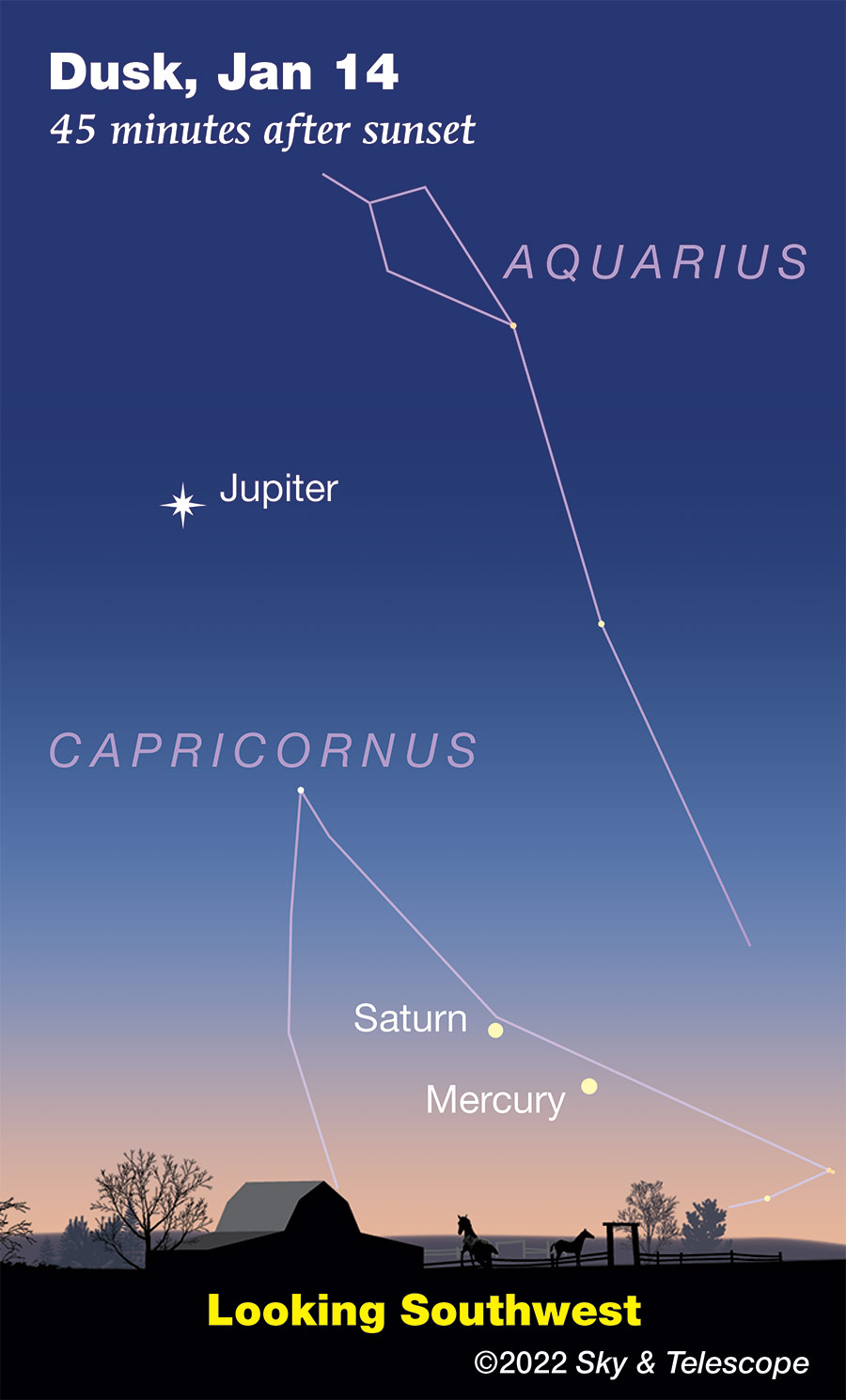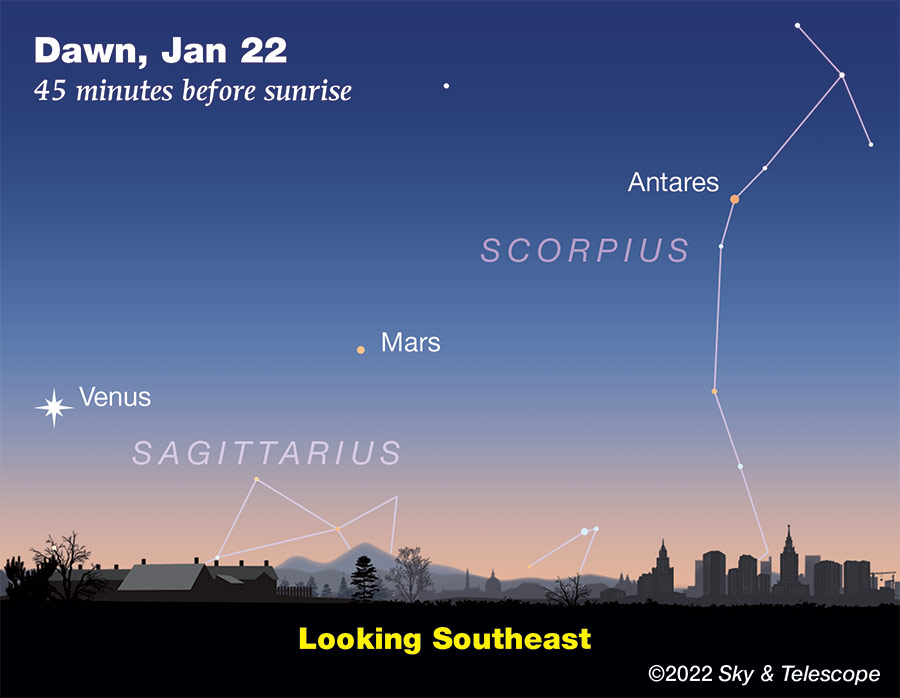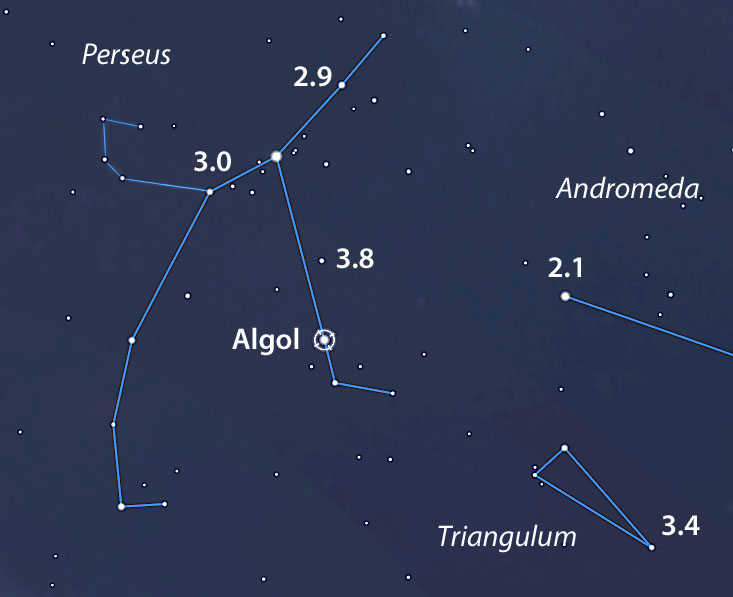FRIDAY, JANUARY 14
■ Jupiter still shines high and bright in the southwest at dusk. But Saturn and Mercury, very far to its lower right, are now quite difficult very low in the sunset afterglow. Bring binoculars!

■ The waxing gibbous Moon this evening shines between the horn-tip stars of Taurus, Beta and Zeta Tauri. This arrangement of Moon between two stars lies midway between, and more or less lined up with, two brighter stars, Capella and Betelgeuse, much farther to either side.
SATURDAY, JANUARY 15
■ Here it's getting to be the very coldest bottom of the year (on average), but the Summer Star, Vega, still hangs in. Barely. Look for it twinkling over the northwest horizon during and shortly after dusk. The farther north you are the higher it will be. If you're as far south as Florida, it's already gone.
SUNDAY, JANUARY 16
■ Castor and Pollux shine left of the almost-full Moon this evening. As the Moon moves along its orbit, the triangle they make changes shape through the night.
MONDAY, JANUARY 17
■ Full Moon (exactly full at 6:48 p.m. EST). Pollux and Castor now shine above it, a little farther from it hour by hour.
TUESDAY, JANUARY 18
■ Sirius twinkles brightly after dinnertime below Orion in the southeast. Around 8 or 9 p.m., depending on your location, Sirius shines precisely below fiery Betelgeuse in Orion's shoulder. How accurately can you time this event for your location, perhaps judging against the vertical edge of a building? Of the two, Sirius leads early in the evening; Betelgeuse leads later. Welcome to pre-telescopic astrolabe astronomy.
WEDNESDAY, JANUARY 19
■ After dark, face east and look very high. The bright star there is Capella, the Goat Star. To the right of it, by a couple of finger-widths at arm's length, is a small, narrow triangle of 3rd and 4th magnitude stars known as "the Kids." Though they're not exactly eye-grabbing, they form a never-forgotten asterism with Capella.
THURSDAY, JANUARY 20
■ The big Northern Cross in Cygnus, topped by Deneb, stands nearly upright over the northwest horizon after dark. As evening grows late it sinks to the horizon and on down into it, like a sword plunging into the ground.
FRIDAY, JANUARY 21
■ Now that the waning Moon doesn't rise until about 9 p.m., is your early-evening sky dark enough for you to see the winter Milky Way? After dinnertime it runs vertically from Canis Major low in the southeast, up between Orion and Gemini, through Auriga and Perseus overhead, and down through Cassiopeia, Cepheus, and Cygnus to the northwest horizon.
■ Iris in Gemini. The asteroid 7 Iris, magnitude 7.8. is just a week past opposition and nicely placed high in Gemini by 7 or 8 p.m. It's under the Pollux stick-figure twin, and above Procyon. Bring your telescope or large binoculars and the finder chart in the January Sky & Telescope, page 49.
Note: The date ticks on that chart, like on all of S&T's asteroid and comet charts, mark 0:00 Universal Time for the dates indicated. In North America this falls in the early evening of the previous date.
Unsure how to relate what you see on the chart to what you see (or don't) in the sky? The secrets are opened for you in How To Use a Star Chart with a Telescope.

SATURDAY, JANUARY 22
■ Zero-magnitude Capella high overhead, and equally bright Rigel in Orion's foot, have almost the same right ascension. This means they cross your sky’s meridian at almost exactly the same time: around 9 p.m. now, depending on how far east or west you live in your time zone. So whenever Capella passes its very highest, Rigel always marks true south over your landscape, and vice versa.
Capella goes exactly through your zenith if you're at latitude 46° north: Portland, Oregon; Montreal; central France.
■ High overhead, the prototype eclipsing binary star Algol should be at its minimum brightness, magnitude 3.4 instead of its usual 2.1, for a couple hours centered on 8:46 p.m. EST. Algol takes several additional hours to fade and to rebrighten. Compare it at a glance to nearby Gamma Andromedae (Andromeda's bright foot), magnitude 2.1.

This Week's Planet Roundup
Mercury and Saturn start the week very low in the west-southwest in twilight, far lower right of Jupiter as shown at the top of this page. Use binoculars. On the 14th they're only magnitudes +0.6 and +0.7, and in a day or two they're gone. (Although the farther south you are, the better.)
Venus (magnitude –4.3) emerges into dawn view. Look for it low in the east-southeast about 45 or 30 minutes before sunrise. It gets higher every day. In a telescope or good binoculars it's a thin crescent, as it was a few weeks ago in the evening sky. But now it's getting thicker every day, not thinner.
Mars, vastly fainter at magnitude +1.5, is low in the southeast in early dawn, some 15° or 20° to Venus's upper right (if Venus has even risen yet). Don't confuse Mars with brighter, Mars-colored Antares to its own upper right. Mars and Antares are 14° apart on the morning of January 15th, widening to 19° by the 22nd.
Mars is on the far side of its orbit from us, so in a telescope it's just a tiny blob 4 arcseconds wide.
Jupiter, magnitude –2.1 in Aquarius, still shines brightly in the southwest at dusk, lower every week.
Uranus (magnitude 5.7, in Aries) is very high in the south in early evening. See Bob King's story and finder chart.
Neptune (magnitude 7.9, in Aquarius) is much lower in the southwest after dark, some 18° upper left of Jupiter. It's invisible without optical aid and a good finder chart.
All descriptions that relate to your horizon — including the words up, down, right, and left — are written for the world's mid-northern latitudes. Descriptions and graphics that also depend on longitude (mainly Moon positions) are for North America.
Eastern Standard Time, EST, is Universal Time (also called UT, UTC, GMT, or Z time) minus 5 hours.
Want to become a better astronomer? Learn your way around the constellations. They're the key to locating everything fainter and deeper to hunt with binoculars or a telescope.
This is an outdoor nature hobby. For an easy-to-use constellation guide covering the whole evening sky, use the big monthly map in the center of each issue of Sky & Telescope, the essential magazine of astronomy.
Once you get a telescope, to put it to good use you'll need a detailed, large-scale sky atlas (set of charts). The basic standard is the Pocket Sky Atlas (in either the original or Jumbo Edition), which shows stars to magnitude 7.6.

Next up is the larger and deeper Sky Atlas 2000.0, plotting stars to magnitude 8.5; nearly three times as many. The next up, once you know your way around, are the even larger Interstellarum atlas (stars to magnitude 9.5) or Uranometria 2000.0 (stars to magnitude 9.75). And be sure to read How to Use a Star Chart with a Telescope.
You'll also want a good deep-sky guidebook. An impressive one is the big Night Sky Observer's Guide set (2+ volumes) by Kepple and Sanner.
Can a computerized telescope replace charts? Not for beginners, I don't think, and not on mounts and tripods that are less than top-quality mechanically, meaning heavy and expensive. And as Terence Dickinson and Alan Dyer say in their Backyard Astronomer's Guide, "A full appreciation of the universe cannot come without developing the skills to find things in the sky and understanding how the sky works. This knowledge comes only by spending time under the stars with star maps in hand."
![]() Audio sky tour. Out under the evening sky with your
Audio sky tour. Out under the evening sky with your
earbuds in place, listen to Kelly Beatty's monthly
podcast tour of the heavens above. It's free.
"The dangers of not thinking clearly are much greater now than ever before. It's not that there's something new in our way of thinking, it's that credulous and confused thinking can be much more lethal in ways it was never before."
— Carl Sagan, 1996
"Facts are stubborn things."
— John Adams, 1770
 3
3









Comments
TenOfSwords
January 14, 2022 at 12:13 pm
While this synopsis mentions that Vega - and Deneb, too - is visible for a time after dusk, it neglects to mention that these two stars are also visible for about the same amount of time before dawn at this time of year.
The further north you are, the longer Vega and Deneb will be visible at both times (in much of Canada, the duo is circumpolar).
The Summer Triangle's third star, Altair, is conceptually visible at both times as well right now - but since Altair is less far north of the ecliptic than either Vega or Deneb, binoculars are recommended for viewing it. Just aim them diagonally lower left of Ophiuchus about 45 minutes before sunrise; any bright object you find there is likely to be Altair - unless of course it's a UFO! LOL
You must be logged in to post a comment.
Rod
January 14, 2022 at 9:41 pm
UFO, good one TenofSwords 🙂
You must be logged in to post a comment.
Rod
January 14, 2022 at 9:44 pm
I was able to enjoy some stargazing tonight under the waxing gibbous Moon 🙂 [Observed 1900-2030 EST/0000-0130 UT. Full Moon 17-Jan-2022 2348 UT. Virtual Moon Atlas shows the waxing gibbous Moon tonight near 400700 km distance and angular size about 29.82 arcminutes. I enjoyed views of the Moon using 40-mm plossl at 25x with Moon filter. Tycho crater with rays, Copernicus crater with rays, Kepler crater with rays, Reiner crater near the terminator line, and Eratosthenes crater area viewed. I cleaned the Moon filter, but some specks continue to show. I tested the view by removing. No specks visible so the Moon filter has some dirt or dings in it. I may need to replace with a new Moon filter. The star 118 Tauri distinctly visible a bit more than 35 arcminutes angular separation from the Moon on terminator side. Starry Night reports this star is about 435 LY, Stellarium shows 433.72 LY with apparent magnitude +5.80, Starry Night + 5.46. I viewed Procyon at 25x with nearly 1.8-degree true FOV. Stellarium 0.21.3 showed many faint stars around Procyon, some 7 to 10.4 magnitude that I could see in the FOV. Other targets observed, M37, M35, M42, and M45. M42 was enjoyable but best seen without bright moon light. I could see 4 stars in the Trapezium. Interesting and fun to test how faint open star clusters or faint stars are visible during the waxing gibbous Moon in my 90-mm refractor telescope. Some altocumulus clouds moved by from NNW at 40 to 50 knots (NWS winds aloft). This was an ethereal view of the Moon with unaided eyes as the clouds passed by quickly. Temperature 1C, winds NNW 14 knots. Earlier in the evening near 1900 EST, I could see Jupiter low in SW sky but did not view with the telescope because of trees, Jupiter bright behind a tree line. Jupiter setting at my location near 2018 EST/0118 UT tonight.]
You must be logged in to post a comment.
You must be logged in to post a comment.